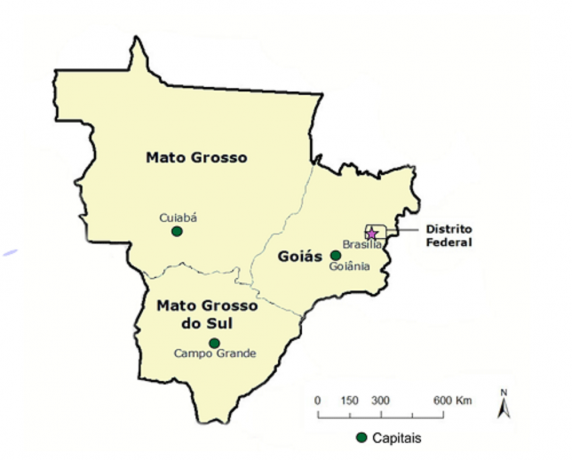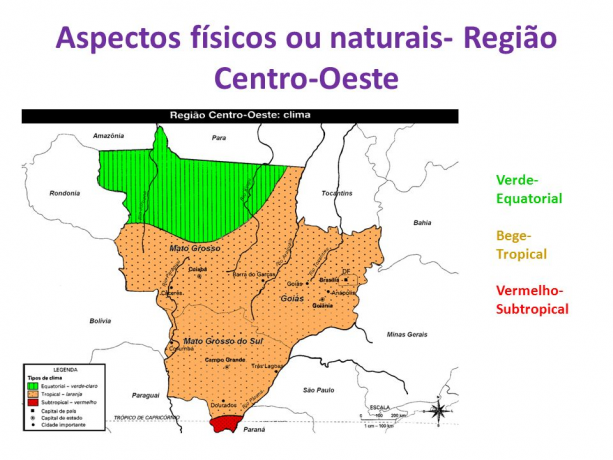
According to IBGE, the Midwest region equivalent to 19% of the Brazilian territory, has more than 15 million inhabitants, when we relate the territorial extension with the population number, we can say that it is a sparsely populated region, it has 467 municipalities and states that make up the Central-West region of Brazil are:
| state | capital |
| Goiás-GO | Goiania |
| Mato Grosso-MT | Cuiabá |
| Mato Grosso do Sul-MS | Large field |
| Brasília - Federal District (DF) |
The main physical characteristics of the Midwest region are:

Index
Before studying the existing climates in this part of the country, we must pay attention to the climatic factors that act in this region. The first factor is the latitude, as it is a region of low latitude, that is, because it is close to the Equator (0°) there tends to be climates with high temperature, the second climatic factor is it deals with continentality, which causes less rainfall, in relation to places close to the sea, and a large thermal amplitude (which consists of the difference between the maximum and minimum temperature). The third climate factor is the relief, the higher the relief altitude, the lower the temperature. The interaction between these climatic factors resulted in the predominance of three climates in the Midwest region:

According to Jurandyr Ross' classification, the main relief units are:
The interaction between climate, relief and soil in the Midwest region gave rise to the following plant formations:
Thick: consists of an intermediate vegetation between a field and a forest, due to its large extension it has a distinct physiognomy, ranging from small scattered shrubs to dry forests, the trees have twisted trunks, due to the acidity of the soil, the roots are deep, to be able to absorb water from the subsoil during the dry period.
This vegetation managed to adapt with the long period of drought, during the winter, it has more than 12 thousand plant species and approximately 11 thousand animal species.
Amazon rainforest: occurs in the North of Mato Grosso, formed by vegetation of large size, dense, with high temperature and rainfall, it has great animal and plant diversity. It is an extension of Amazonian vegetation in the Midwest region.
Pantanal: is located in the Pantanal plain region, the largest floodplain in the world, the characteristics of the vegetation change accordingly with the humidity of the place, when wet it assumed the characteristic of dense forest, when dry it has characteristics of the vegetation of the thick.
Tropical forest: It is the Atlantic Forest, which was present in a part of the states of Goiás and Mato Grosso do Sul, it is a large vegetation. size, humid, with high rainfall (lower than in the Amazon region), dense, heterogeneous, with great animal diversity and vegetable.
All these vegetation described are targets of deforestation, the cerrado has suffered from arson fires, in addition to the removal of vegetation to occupy the soil with agriculture and livestock. The Atlantic Forest was practically extinct in the Midwest region.
See too:
The National Water Agency (ANA) classified 5 hydrographic regions in the Midwest region, among which the most outstanding are:
Amazon Hydrographic Region: As described above, the North of Mato Grosso borders the Amazon region, so the climatic characteristics, vegetation and hydrography are similar. In the North of Mato Grosso there are rivers that are tributaries of the Amazon, they are rivers of great extension and flowing.
Hydrographic Region of Paraguay: the main river is the Paraguay, which is important for the region's nature and also for navigation and product flow. This hydrographic region is not located entirely in Brazil, it is also found in Bolivia, Paraguay and Argentina.
Tocantins-Araguaia Hydrographic Region: the main river is the Araguaia and its largest tributary is the Tocantins river, in this hydrographic region is located the largest fluvial island in the world, Ilha de Bananal.
Subscribe to our email list and receive interesting information and updates in your email inbox
Thanks for signing up.


